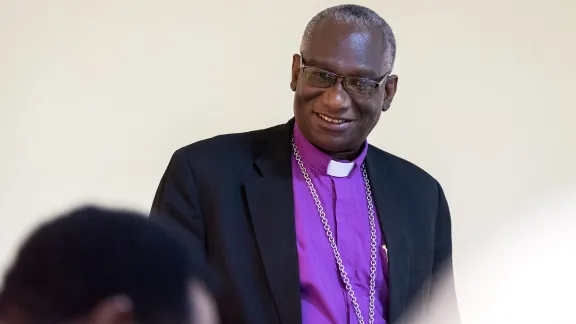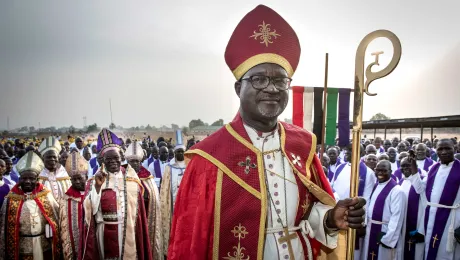
Bishop Fredrick Onael Shoo from the Evangelical Lutheran Church in Tanzania’s (ELCT) Northern Diocese. Photo: LWF/Albin Hillert
Tanzanian Bishop Fredrick Shoo on nurturing faith, youth, and nature
(LWI) - At the foot of Mount Kilimanjaro the Evangelical Lutheran Church in Tanzania’s (ELCT) has planted millions of tree saplings over the past two decades, changing climate and communities for the better. "Most importantly, people’s attitudes have changed," says Bishop Fredrick Onael Shoo who leads the ELCT’s Northern Diocese, looking back on impact of a reforestation initiative he started in 2005.
Initially, members of the congregations did not see why Christians should plant trees. „We had to explain that we are part of God’s creation, and as an expression of our faith, we are called to care for our environment and the natural resources that sustain us.“ As a result of this ongoing advocacy, the communities and congregations living at the foot of Mount Kilimanjaro can now see the effects of the millions of tree saplings they planted in the last two decades.
Trees play a vital role for the region’s water cycle
According to a 2016 report by the UN Environment Programme (UNEP), Mount Kilimanjaro’s forests are a vital water source for the surrounding towns and the wider region. Trees trap water from clouds, and water from the mountain feeds one of Tanzania’s largest rivers, the Pangani, and provides food, fuel, and building materials to much of East Africa.
The UNEP report titled “Sustainable Mountain Development in East Africa in a Changing Climate” notes that higher temperatures due to climate change have increased the number of wildfires on the mountain and thus accelerated the destruction of forests. Because there are now fewer trees to trap water from clouds, the annual amount of dew on Mount Kilimanjaro has fallen by 25 percent.

The Kilimanjaro region near Moshi in Tanzania. Photo: Unsplash/Anthony Njau
The town of Moshi, located in the foothills of Kilimanjaro, is among towns that has experienced water shortages as rivers dry up, starving farmland of water in an area already struggling to cope with a dramatic drop in rainfall.
Caring for creation – an intergenerational and interfaith concern
Young people are a crucial group the ELCT addresses with the message of caring for creation. At the beginning of their two-year confirmation course, every confirmand gets ten saplings to plant and care for. That means that about 20,000 trees are planted every year. „At the end of the course, we go and see what has become of them,“ says Shoo. „I often see the youth proudly presenting their trees.“
Green trees and shade now surround church compounds that stood dry and barren. Some of the trees even grew into small forests. „We observe that about 85 percent of the trees we plant survive,“ the bishop explains. As the area has become drier, the saplings must be tended until their roots are deep enough to sustain the tree.
Green trees and shade now surround church compounds that stood dry and barren. Some of the trees even grew into small forests. „We observe that about 85 percent of the trees we plant survive,“ the bishop explains. As the area has become drier, the saplings must be tended until their roots are deep enough to sustain the tree.
In the surrounding communities, people have started replanting indigenous trees near fountains and riverbeds that had run dry after forests had been felled to grow crops or to make charcoal. „As the trees were tended, grew and ecosystems could reestablish, we observed that fountains slowly started flowing again,“ Shoo says.
As the trees returned, the rains improved, and when the storms came, they no longer swept away the villages. The animals and wildlife are returning.
Joining hands with other faith groups, the ELCT urged government bodies to enforce existing laws against logging in the rainforest of Kilimanjaro. „That is important to maintain the natural environment and the biodiversity we need to sustain the people living in this area,“ Shoo explains. UNEP supports that approach, urging Tanzania to protect Mount Kilimanjaro’s water catchment area, among others, by reforesting the mountain.


